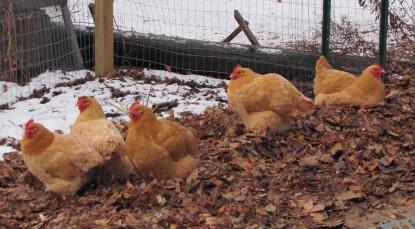
April may be the cruelest month, but February doesn’t bestow wanton kindness. Even on clear days the sun doesn’t withholds heat and on most days it strains to break the clouds. This deprives us of the opportunity to synthesize vitamin D, and brings on seasonal affective disorder (S.A.D.).
In vertebrates day length affects the hormone outputs of the pineal gland. This in turn entrains our bodies to the circadian cycle of earth. We’re never content with the lot the earth throws at us so we’ve invented things to turn the night into day. The light bulb has given us the illusion of daytime anytime. I write “illusion” because all light is not daylight. My chickens have demonstrated this amply this winter.
Domesticated hens lay eggs when their brains decide the days are long enough. I’ve been keeping a 26 watt compact fluorescent in my coop over the winter to increase laying. It’s been wildly unsuccessful. I read that you need at least a 40 watt bulb to give enough light to induce chickens to lay. I got the information initially from a pretty standard chicken book, but I hadn’t given it much thought until a frequent poster on a local chicken list serve re-iterated it and recommended an incandescent bulb. This particular commenter knows a lot about chickens, but is weak on the scientific reasons. Her commented made me realize I had made a mistake.
The 40 watt minimum was calculated for an incandescent bulb. Incandescent bulbs convert most of the electricity they use to heat (~90%) and emit the remaining energy as light. A 40 watt bulb provides about 600 lumens (we’ll call that brightness, though that’s inexact). My 26 Watt fluorescent bulb clobbers that with brightness at 1560 lumens. But the chickens would not lay.
My mistake was basic: when attempting to communicate day length to organisms, you have to pay attention not just to power and brightness, but wavelength. So I was saving money on electricity, but getting no eggs.
We’re all familiar with the spectrum of visible light from the cover of Floyd’s Dark Side of the Moon: sunlight shined through a prism gives you a rainbow. The short wavelengths have more energy and are at the violet end, the longer wavelengths at the red end have less energy. Sunlight gives a lot of all wavelengths. Most of our artificial lights are poor imitators of the sun. If you shine an incandescent bulb through that prism, you wouldn’t get much of the blue and green colors, but you’d have plenty of red. Fluorescent bulbs have sparse peaks in blue, green and orange with generally poor output in between and not much red. LEDs can be fine-tuned to do just about anything depending on how they’re mixed, but for the most part they too give a poor imitation of the sun.
According to “Proper light management for your home laying flock” by Zadina and Scheideler, extension poultry specialists at the University of Nebraska, chickens need the red light to lay. They have evolved to react to that end of the spectrum and blue light won’t do it. So my fluorescent bulb was bathing them in very bright light, but failing to get them to lay. They could read just fine.
So I swapped it for an incandescent that I had around the garage. Within a week I went from 3 or 4 eggs a week to 20. Of course, I can’t be sure the light bulb can account for the change. I didn’t control for the fact that the days are getting longer. But for eight hens in my home flock, this is good enough for now.


